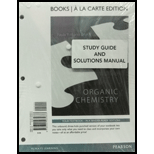
Study Guide And Student Solutions Manual For Organic Chemistry, Books A La Carte Edition (7th Edition)
7th Edition
ISBN: 9780321934833
Author: Paula Yurkanis Bruice
Publisher: PEARSON
expand_more
expand_more
format_list_bulleted
Question
Chapter 18.13, Problem 28P
Interpretation Introduction
Interpretation: The given following esters which cannot undergo claisen condensation has to be predicted.
Concept introduction: When two molecules of an ester undergo condensation is called claisen condensation. Like in aldol reaction, in claisen condensation one molecule is a nucleophile and the other molecule is an electrophile.
A claisen condensation reaction is a reversible reaction and occurs in the presence of a strong base.
The first step of claisen condensation is the removal of a proton from alpha carbon by a base and then the addition of enolate ion formed to the second ester molecule forming a β-ketoester.
Expert Solution & Answer
Want to see the full answer?
Check out a sample textbook solution
Students have asked these similar questions
Which of the esters cannot undergo Claisen self‑condensation?
Which of the following compounds is easier to decarboxylate?
Which of the following does not support a nucleophilic attack of a covalent catalysis?
a. Hydroxyl
b. Sulfhydryl
c. Imidazole
d. Amino
e. Methyl
Chapter 18 Solutions
Study Guide And Student Solutions Manual For Organic Chemistry, Books A La Carte Edition (7th Edition)
Ch. 18.1 - Prob. 1PCh. 18.1 - Prob. 2PCh. 18.1 - Prob. 3PCh. 18.1 - Prob. 4PCh. 18.1 - PROBLEM 5♦
List the compounds in each of the...Ch. 18.2 - Explain why 92% of 2,4-pemtanedione exists as the...Ch. 18.3 - Draw the enol tautomers for each of the following...Ch. 18.3 - Prob. 8PCh. 18.4 - Prob. 9PCh. 18.4 - Prob. 10P
Ch. 18.5 - Show how the following compounds can be prepared...Ch. 18.6 - What compound is formed when a dilute solution of...Ch. 18.7 - Prob. 13PCh. 18.7 - Prob. 14PCh. 18.7 - How many stereoisomers are obtained from each of...Ch. 18.7 - Prob. 16PCh. 18.8 - Prob. 17PCh. 18.9 - Prob. 18PCh. 18.9 - Prob. 19PCh. 18.10 - Prob. 20PCh. 18.10 - What aldehyde or ketone would be obtained when...Ch. 18.11 - Prob. 22PCh. 18.12 - Prob. 24PCh. 18.12 - What two carbonyl compound are required for the...Ch. 18.12 - Propose a mechanism for the following reaction:Ch. 18.13 - Draw the products of the following reactions:Ch. 18.13 - Prob. 28PCh. 18.13 - Prob. 29PCh. 18.14 - Prob. 30PCh. 18.15 - Write the mechanism for the reaction of a...Ch. 18.15 - Prob. 32PCh. 18.15 - Prob. 33PCh. 18.15 - Draw the product of the reaction of each of the...Ch. 18.16 - Draw the product obtained by heating each pair of...Ch. 18.16 - Prob. 36PCh. 18.17 - Prob. 37PCh. 18.18 - Prob. 38PCh. 18.18 - Prob. 39PCh. 18.19 - Prob. 40PCh. 18.20 - Prob. 42PCh. 18.21 - Propose a mechanism for the formation of...Ch. 18.21 - Prob. 44PCh. 18.21 - a. If the biosynthesis of palmitic acid were...Ch. 18.21 - Prob. 46PCh. 18 - Prob. 47PCh. 18 - Prob. 48PCh. 18 - Number the following compounds in order of...Ch. 18 - The 1H NMR chemical shifts of nitromethane,...Ch. 18 - Prob. 51PCh. 18 - Draw the products of the following reactions: a....Ch. 18 - A racemic mixture of 2-methyl-1-phenyl-1-butanone...Ch. 18 - Prob. 54PCh. 18 - Prob. 55PCh. 18 - Prob. 56PCh. 18 - Prob. 57PCh. 18 - Identify A-L. (Hint: A shows three singles in its...Ch. 18 - Using cyclopentanone as the reactant, show the...Ch. 18 - Show how the following compounds can be prepared...Ch. 18 - Prob. 61PCh. 18 - Prob. 62PCh. 18 - Prob. 63PCh. 18 - The ketone whose 1H NMR spectrum is shown here was...Ch. 18 - Prob. 65PCh. 18 - Compound A with molecular formula C6H10 has two...Ch. 18 - Indicate how each of the following compounds can...Ch. 18 - Draw the products of the following reactions:Ch. 18 - Prob. 69PCh. 18 - a. Show how the amino acid alanine can be...Ch. 18 - Prob. 71PCh. 18 - Show how the following compounds can be...Ch. 18 - Explain why the following bromoketone forms...Ch. 18 - Prob. 74PCh. 18 - What carbonyl compounds are required to prepare a...Ch. 18 - Prob. 76PCh. 18 - A carboxylic arid is formed when an -haloketone...Ch. 18 - An , -unsaturated carbonyl compound can be...Ch. 18 - Prob. 79PCh. 18 - A Cannizzaro reaction is the reaction of an...Ch. 18 - Propose a mechanism for each of the following...Ch. 18 - The following reaction is known as the benzoni...Ch. 18 - Prob. 83PCh. 18 - Prob. 84PCh. 18 - Prob. 85PCh. 18 - Prob. 86PCh. 18 - Propose a mechanism for the following reaction:
Knowledge Booster
Similar questions
- Draw what compounds would result from complete hydrolysis of the following heterocyclic compound.arrow_forwardPredict the product of the following acetal hydrolysis reaction.arrow_forwardExplain why the following alkyl halide does not undergo a substitution reaction, regardless of the base that is used.arrow_forward
- Draw all possible elimination products for the followingarrow_forwardWhich of the following pairs of compounds are keto-enol tautomers?arrow_forwardWhat is the importance of proton transfer in the formation of ester? A.The carbonyl carbon is easily attacked by the nucleophile. B. The oxygen that has been attached to the two alkyl groups will become stable. C. The removal of a bulky substituent attached to the reactive site stabilizes the compound. D. none of the abovearrow_forward
arrow_back_ios
SEE MORE QUESTIONS
arrow_forward_ios
Recommended textbooks for you

 Organic Chemistry: A Guided InquiryChemistryISBN:9780618974122Author:Andrei StraumanisPublisher:Cengage Learning
Organic Chemistry: A Guided InquiryChemistryISBN:9780618974122Author:Andrei StraumanisPublisher:Cengage Learning


Organic Chemistry: A Guided Inquiry
Chemistry
ISBN:9780618974122
Author:Andrei Straumanis
Publisher:Cengage Learning